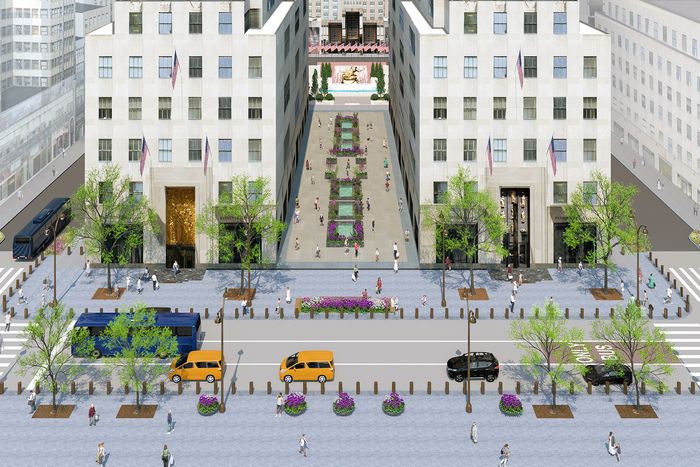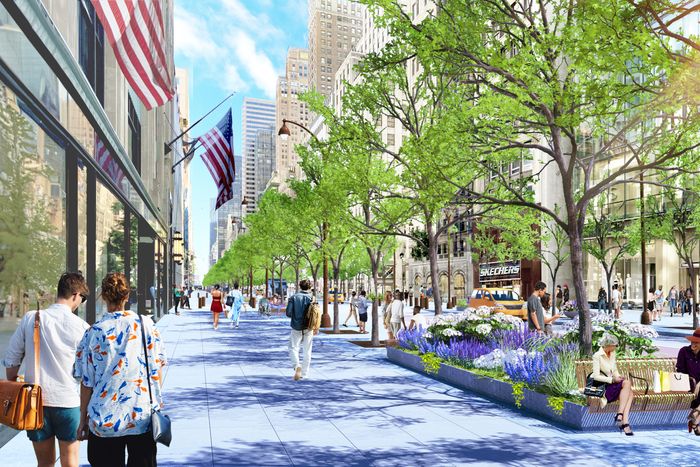It’ll Be a Whole New Fifth Avenue

By the end of the 1930s, the midtown blocks of Fifth Avenue had gone through a fast and decisive change. New Yorkers barely into middle age could remember the boulevard, a couple of decades earlier, as a residential neighborhood of Gilded Age single-family-with-many-servants mansions; now it had finally and fully given way to commerce, represented by department stores like Best & Co. and Saks Fifth Avenue as well as the immense new Rockefeller Center complex. In March 1939, the city tried in a small way to restore a little grace to the limestone canyon. “That business section of Fifth Avenue, which has not known the sight of trees since the days of the stately mansions and the horse and buggy,” one press outlet wrote, “took its first step in arboreal recovery … when this stately 50-foot elm tree, the first of eight to be planted at Rockefeller Center, was placed into the huge pit prepared for it at Fifth Avenue and 51st Street.”
The elms didn’t last, although there are more trees along the sidewalks today, including one in that same curbside spot. (Honey locust.) Nor did the instinct to humanize Fifth Avenue, which in the past 70 years has mostly grown inhospitable to movement that isn’t on four wheels. A dopey Giuliani-administration scheme to channel pedestrian flow never worked, although the stupid steel fences that Rudy demanded stuck around until 2018. Today’s auto-centric plan doesn’t work for drivers either: It is not uncommon to see standstill traffic in front of Rockefeller Center at midnight. Pedestrians are uncomfortably packed on the sidewalks, too, especially during summer-tourist and holiday-shopping seasons. Fifth Avenue, you could argue, is a victim of its own success. Everyone wants a piece of it, and there isn’t enough to go around.
Just weeks after announcing a plan (or at least the preparative study of a plan) to reconstruct Park Avenue in its premodern, superior form, the city has just revealed a major makeover for Fifth. Essentially, it has had to rule among all those conflicting needs and demands, and its excellent decision has been to give a lot of the space over to walking people rather than moving vehicles. From the bottom of Central Park down to 42nd Street, five lanes will become three, one of them given over to buses. The sidewalks will approximately double in width, with another band of space given over to tree pits, supplying a blessed bit of shade. There will be places to sit and planters. Construction is to begin in 2028.
Although it is not the perfect New York street that Curbed laid out a few years ago, it incorporates many of these ideas. Most obviously missing is a dedicated bike lane; my hunch is that, with so many tourists and residents using Fifth on foot, the city is concerned about the prospect of collisions between fast-moving messengers and middle Americans unaccustomed to moving on foot. The Sixth Avenue bike lane will, the city told the New York Times, be expanded and become bidirectional to compensate.


A couple of representative blocks, as seen from across the street..
A couple of representative blocks, as seen from across the street..
Much of what we see here is growing commonplace in the rest of the developed world. Mayor Anne Hidalgo, in Paris, has clawed back vast amounts of her city from traffic. More broadly, the movement to pull back street space from the automobile is a driving (so to speak) principle of contemporary urban planning. Utrecht, a mid-size city in the Netherlands, had the customary “traffic sewer” rammed through its civic core at mid-century, and all that space has been reclaimed. Boston spent 20 nightmarish years dealing with construction detours and budget overruns, delivering it the Rose Kennedy Greenway through its center and traffic that moves invisibly below. The Fifth and Park Avenue makeovers are utterly modest by comparison, but they are also enormous improvements on what we have, in part because we are so far behind the curve and so resistant to change.
We have done some of this here, too, and it is hard to describe any of it as less than a success. When Times Square was mostly pedestrianized, under Mayor Mike Bloomberg and his transportation guru, Janette Sadik-Khan, there was a huge amount of shouting. Twenty years on, New Yorkers still hate to go there, of course — they always will — but when I arrived there too early for an appointment recently and had 20 minutes to kill, I was struck by how not so terrible it is as a place to sit and people-watch. Fewer drivers are hitting pedestrians there, too. The little plaza extending up Broadway from Herald Square is a fine place to meet for coffee. The one by the Flatiron Building is even better. Linking them all up into one big constellation of Broadway mallitude would not be a bad thing.
Photo: City Hall
The de Blasio administration tried a version of the Fifth Avenue plan, and couldn’t get it over. The Adams team’s announcement came from the mayor as well as Meera Joshi and Ya-Ting Liu, two of the few major figures in City Hall who have not been dinged lately, and Maria Torres-Springer, who took over the role of first deputy mayor just days ago. More than that, though, it has explicit backing from lots of other public, private, public-and-private, and activist entities — the Fifth Avenue Association, the Grand Central Partnership, the Central Park Conservancy, the Bryant Park Corporation, the Regional Plan Association, the New York League of Conservation Voters, Open Plans. That suggests that this is pre-cleared, so to speak: Most everyone with power who would be able to say no has already been consulted and brought around to a yes. The last hurdle in these situations is typically community opposition: residents who pound their firsts about increased traffic, about ambulance access, about the loss of parking spots, about any change to the status quo. (The Times story, notably, says that “a public meeting about the plan will be held on October 29, and the overall design could be revised. But the plan does not require major approvals that could block it entirely.”) This stretch of Fifth has comparatively few residents to be cranky about it (beyond a couple of notable mixed-use towers), and virtually no curbside parking to argue about, perhaps defanging the opposition somewhat. Besides, who the heck shops at Bvlgari and expects to park out front? You just call your driver and have him pull around.
Photo: City Hall
Source link





